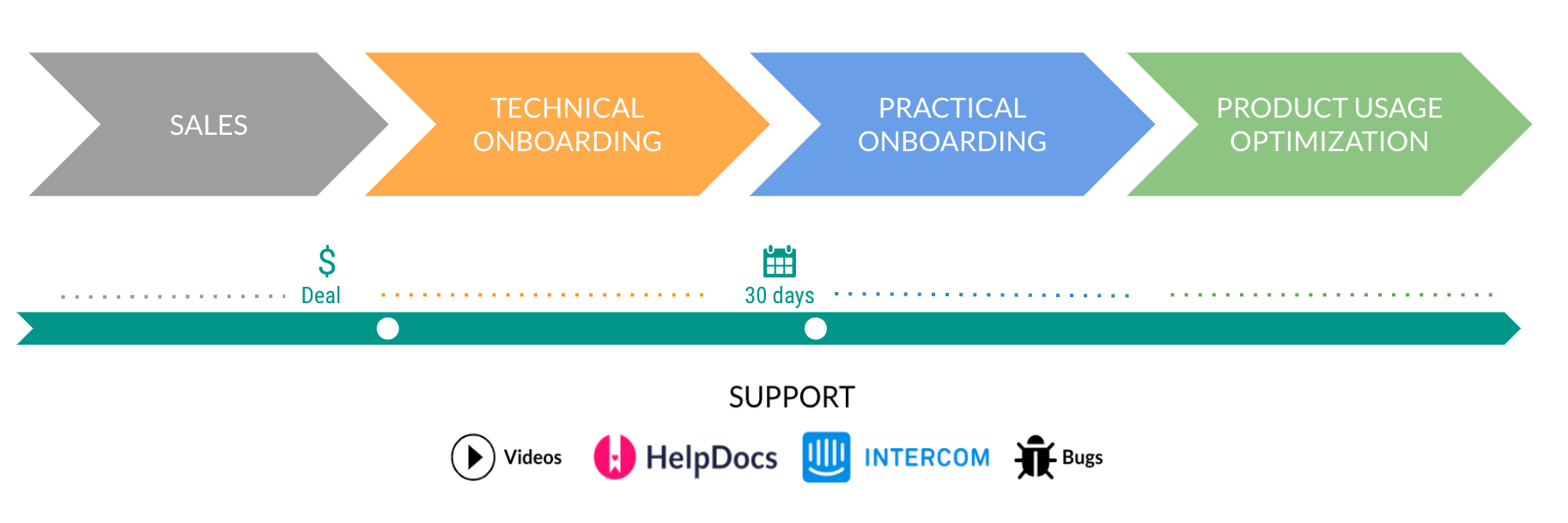The Onboarding Process
Within your Sales process you can choose to stay at your free package or, depending on your set up, upgrade to either the TEAM, BUSINESS, or ENTERPRISE package.
To help you decide on which package to choose here are some details about what they include in terms of support:
FREE | TEAM | BUSINESS | ENTERPRISE |
|
|
|
|
WHAT YOU WILL MISS: The downside of the Free package is that you wont have a dedicated CSM assigned and personal trainings. No customisation of stage and attribution models Just recommended to try out the product but not proper reporting! | WHAT YOU WILL MISS: The downside of the Team package is that you wont have a dedicated CSM assigned and personal trainings. No customisation of stage and attribution models Recommended for small companies that would love to dive into the world of attribution and use this for their reporting. | WHAT YOU WILL MISS: In the business tier, you’ll get a dedicated CSM, and as much training as needed in order to fully comprehend the platform and the product within. The downside is that you’ll be missing personal customisation. | WHAT YOU WILL MISS: Nothing! You will get a dedicated CSM, as well as personal training sessions. And in case you would like to customise the stages or attribution models we will include our experts to assist you. |
If you are in the Enterprise customer tier, this is how the onboarding process at Dreamdata looks like:

After having a high level introduction by Sales you will be introduced to your Customer Success Manager who will accompany you on your journey to success!
The Onboarding process consists of two main parts: The Technical and Practical Onboarding
The Technical Onboarding
During technical onboarding, we will help you with setting up the sources, and defining your stage models. Depending on your setup this process can take 4 to 6 weeks until we have adjusted everything to your convenience.
To help us speed up the process we will need specific information from you. The following questions will help us prepare for the weeks to come, and to get you up and running as fast as possible.
What are your goals?
1. KPIs
What are you measuring yourself on internally throughout the different departments that would be working with the Dreamdata platform? e.g. Number of MQLs generated.
The answers to these questions would give us a foundation for what areas of the platform to provide you training in along with better suggestions on how to report through the platform.
2. Sales funnel
We need to know the stages in your sales funnel since these will need to be mapped in our backend to make sure that we are showing all of your leads, deals created and deals won etc. from your CRM.
3. Leads value
Leads are a contact, and contact doesn’t have to be associated with a company. If this is the case we will not be able to fetch the CRM value. So you will have to provide with a fixed value that we can assign to leads.
4. Reporting
How are you currently reporting?
It would be beneficial for us to know what you are currently reporting on through out the different departments that will use the Dreamdata platform actively. What is it that management or your executives expect your to report on monthly, quarterly etc.?
5. Desired reporting
This might be a bit harder to answer since you do not know the full capabilities that you will get through the Dreamdata platform.
But think about it this way; what are the pains that you would like to relief in your daily work processes and try to see if you can convert those into reporting. This is also something that you'll be delving deeping into along with your CS Manager.
6. Activities → What to track
- UTM’s
- Channels
- Calls
- Emails
- Forms
- Events
7. Segmentation
What are the sizes of your deals and by what revenue would you like to group them? e.g. <1000, >1000, 12,000
How do you want group days to value? e.g. <90, >180, 90-180
8. Content
We would like you to map out the content categories on your website that you would like to report on. An example could be: Blog, white papers, resources etc.
When we get into a proper training we will show you how you can do it yourself from the Dreamdata platform.
9. Expectations and timeframes
This is your chance to tell us what pace you want to go with. If you have some big reports coming up, quarterly or yearly etc., let us know so that we can try to adjust the schedule accordingly.
The Practical Onboarding
The practical onboarding, also called user training, is where we'll demonstrate the platform and show case its prowess!
We will start training you and your colleagues on the various dashboards according to your needs.
We can provide you with either group or 1:1 trainings and therefore it is important that you introduce us to the teams and inform us about their roles and expectations.
-> What we need to know:
The names and roles of the team members that will be working with the Dreamdata platform. Try to list them after department or areas of expertise. This will make it easier for us to structure and plan your training schedule.
-> These are the topics we provide training in:
THE TRAINING SESSIONS | |
1. Overall Introduction to the full System and how to set up the Data Platform |
|
2. High level introduction to Revenue Analytics |
|
3. High level introduction to Performance |
|
Product Usage Optimization
At Dreamdata, we are committed to being your reliable partner.
This means that we'll always be ready to assist you in reconfiguring and optimising your settings in the platform whenever changes are made on your end.
We understand that your needs evolve over time. So, whether it's tweaking settings or adding new features, we're always ready to help.
Some of these changes only takes a couple of minutes for our team to reconfigure for you, so feel free to reach out to either your personal CS Manager or through our support channel at friends@dreamdata.io
Thank you!
